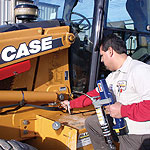Author: Metro Hydraulic Jack Co.
Building Bridges with Hydraulics
Innovations for Hydraulics: Advanced Bridge Construction
Fall Protection in Construction
- Guard every floor hole into which a worker can accidentally walk (using a railing and toe-board or a floor hole cover).
- Provide a guard rail and toe-board around every elevated open sided platform, floor or runway.
- Regardless of height, if a worker can fall into or onto dangerous machines or equipment (such as a vat of acid or a conveyor belt) employers must provide guardrails and toe-boards to prevent workers from falling and getting injured.
- Other means of fall protection that may be required on certain jobs include safety and harness and line, safety nets, stair railings and hand rails.
- Provide working conditions that are free of known dangers.
- Keep floors in work areas in a clean and, so far as possible, a dry condition.
- Select and provide required personal protective equipment at no cost to workers.
- Train workers about job hazards in a language that they can understand.
What Makes a Jack a Hydraulic Jack?
It’s obvious that we know a thing or two about hydraulic jacks at Metro Hydraulic Jack Co.; they’re the basis of our business. Most people have an idea of what jacks are, but there is a lot that goes into these load bearing tools.
When people think of jacks, most often mechanical jacks would come to mind. This category of jacks most notably covers car jacks as well as house jacks. Hydraulic jacks like bottle jacks and floor jacks on the other hand, are used to lift loads that are even heavier.
Hydraulic jacks use multiple cylinders to create pressure by applying force. By putting force on one cylinder, it will create pressure in all connected cylinders. These jacks will have one cylinder larger than the other to produce a greater force, despite the fact that the same pressure is applied in both cylinders.
Using this method, oil is pushed into the two cylinders by pump plungers. This moves the oil through an external discharge check valve before it reaches the cylinder chamber. The valve on the chamber closes to build pressure in the cylinder.
There are several types hydraulic of jacks used for different applications. Bottle jacks are most popularly used for lifting cars for auto inspections, and floor jacks are used to lift items that need a larger lifting pad. Despite their differences, these, along with other varieties of hydraulic jacks all function with the same basic structure.
Building NYC’s 2nd Ave. Subway
The New York City subway system is one of the largest mass transit systems in the world, and NYC’s Metropolitan Transit Authority (MTA) is making it bigger. Currently, the MTA is constructing the Second Avenue subway line to accompany the city’s existing trains, but this isn’t the first time this subway line was contemplated.
The Second Ave. subway line was conceived originally, with the idea of an East Side train dating back to the 1920’s. According to Second Avenue Saga the train was originally planned to be built from 1930 to 1935, but was abandoned after the stock market crash of that era. There were several more attempts over the past eight decades that all fell through.The unconstructed train line even getting a nod on AMC’s period-drama “Mad Men.”
According to the MTA website,“The Second Avenue Subway will reduce overcrowding and delays on the Lexington Avenue line (4, 5, and 6 trains), improving travel for both city and suburban commuters, and provide better access to mass transit for residents of the far East Side of Manhattan.” . The project will cost $4.45 billion and is being built in phases. The first phase will provide service between 96th St. and 63rd St. as via a rerouted Q train by December 2016.
Even though the idea for this line came almost a century ago, the construction process is anything but old fashioned. Below is a video from the MTA website that shows a “Milestone” event of a tunnel boring machine breaking through a rock wall east of the Lexington Ave-63rd St. subway station.Construction Season Gives Hope To Sandy Victims
Hurricane Sandy devastated the American Northeast last October and people are still feeling the effects. Now that construction season is kicking into gear, victims of the superstorm can look forward with optimism.
Late spring and summer are the busiest times of the year for construction workers and parts of the eastern coast of New Jersey, along with New York City and the south shore of Long Island are in need of repair. Post-Sandy construction has already aided the construction industry, with employment in the first quarter reaching over 111 thousand, up 1.3 percent from the previous year according to Crain’s New York.
The construction work goes beyond just rebuilding homes and commercial buildings damaged by the storm. The Rockefeller Foundation recently announced that it is investing $100 million in a project that will make the NYC more resilient.
“In this world today we will not be able to predict or prevent every catastrophe, take climate change—extreme weather, raging fires, vicious storms,” Rockefeller Foundation President Judith Rodin said according to the Daily Beast. “That’s where resilience comes in. We can prevent their catastrophic impact much better, by implementing resilience strategies that let us buffer those shocks more effectively.”
The investment will feature such advancements as emergency management learning mechanisms, new water waste systems, innovating ideas for urban housing and land use planning focused on resilience principles.
Constructing homes and commercial buildings, along with making the areas safer is aiding everyone involved. Bringing NY and NJ back to life after the devastating storm over six month ago is rebuilding the construction industry.
Did You Know We Repair And Sell Lubrication Systems Too?
- Graco
- Alemite
- John Dow Industries
- Balcrank
- Samson
- Lubeq
- National Spencer
- Cox Reels
- Reelcraft
- Containment Solutions, and other manufacturers.
We’ve been repairing hydraulic cylinders for over 60 years. So we’ve earned the title of “experts!”
When Hurricane Sandy hit, we were there to help.
- Auto equipment
- Jacks and garage equipment.
- Hydraulic cylinders.
- Pumps, motors, and tools.
- Lubrication equipment and systems
- Snow plowing equipment repairs.
- Transportation industry
- Track and jacking tools used for trains and the repair of engines, cars, and trucks.
- Ground support equipment and aircraft jacks
- Material handling industry
- Scissor lifts and lift tables
- Pallet jacks

 Search
Search













